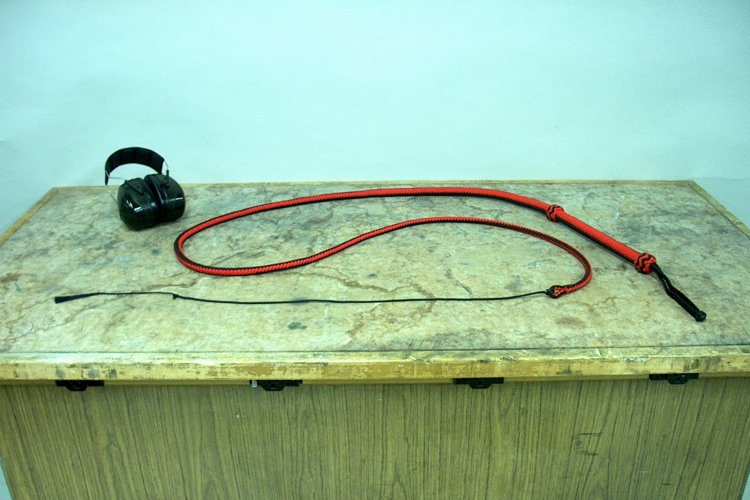
(Thanks to Prof. Everett Lipman for requesting this demonstration, and for help in obtaining the equipment.)

(Thanks to Prof. Everett Lipman for requesting this demonstration, and for help in obtaining the equipment.)
A bullwhip is a type of whip that ranchers often use to drive cattle. While designs vary, most bullwhips have a handle (at right in the photograph above, between the two round decorative knots), a long, tapered section called the thong, then a narrower section, either extending from the core of the thong or attached to the end of the thong, called the fall, and then, tied to the end of the fall, a very thin section called the cracker. A wrist loop (black loop at the end of the handle) helps to prevent the user from losing the whip in case the handle slips out of his hand, and it provides a way of hanging the whip when it is not in use. Most bullwhips used in the field are made of leather. Ours, a stage prop from Western Stage Props, is made of nylon.
The idea in using a bullwhip is not to strike the cattle. After all, one would not want to anger such massive animals. Rather, the bullwhip is designed to take advantage of the relationship between the speed of a wave in a cord or rope, and the mass per unit length of the cord or rope. (See demonstrations 40.54 -- Waves on cord, tubing, spring; and 40.75 -- Standing waves on cord.) In terms of the tension, T, and the mass per unit length, μ, the speed of a wave, v, along a rope is v = √(T/μ). When extending the bullwhip, by giving the handle a flick, the user can send a pulse traveling from the handle, down the whip to the cracker. As the pulse travels through the tapered thong, the mass per unit length is decreasing, so the pulse travels faster and faster. It travels even faster through the fall, whose mass per unit length is much less than that at the end of the thong, and then even faster when it gets to the cracker, which is even thinner. By the time the pulse gets to the end of the cracker, it is traveling faster than the speed of sound in air. (Which is 331.3 m/s at 0° C. The speed of sound in a gas equals √(γRT/M), where γ is the heat capacity ratio, Cp/Cv (= 1.40 for air at STP), R is the ideal gas constant, T is the temperature in Kelvins, and M is the molar mass of the gas (about 29 g/mol for air). See demonstration 44.03 -- Speed of sound in air vs. helium.) This creates a shock wave, which sounds as a loud “crack!” and startles the cattle into moving in the desired direction. (As most people who have spent significant time in locker rooms know, it is also possible to do this with a bath towel by rolling it diagonally, so that one has a very thick handle at one end of an ever-narrowing helix, at the other end of which is the opposite corner of the towel. A well-executed flick of the handle gives a loud “snap!” at the opposite end. The bullwhip, however, is probably much more effective.)
When an object travels (in air) faster than the speed of sound, it creates a series of spherical wavefronts that crowd together in the direction of the object’s motion (because they cannot propagate as fast as the object is moving). The superposition of these wavefronts results in a cone-shaped shockwave, with the object at its apex, and whose angle θ to the direction of motion is given by sin θ = v/vs, where v is the speed of sound in air, and vs is the speed of the object (the subscript “s” stands for “source”). It is similar to the bow wave made by a speedboat traveling in water, except that the wave made by an object traveling on water faster than sound reduces to a pair of lines instead of a cone. In aerodynamics, the ratio vs/v is called the Mach number, after Ernst Mach.
Because the sound made by the end of the bullwhip can be quite loud, it is advisable, when you are cracking the whip indoors, to use ear protection, such as the ear muff shown in the photograph above. You should also warn students in the first few rows of the lecture hall that they should cover their ears. Though operating the bullwhip is not especially difficult, it does require a bit of technique, and it is advisable to practice a bit before you perform the demonstration. The video at the following link provides a clear, detailed description and demonstration of the technique: https://www.youtube.com/watch?v=xUVTvmwFBZk
References:
1) Resnick, Robert and Halliday, David. Physics, Part One, Third Edition(New York: John Wiley and Sons, 1977), pp. 412-413, 449-450.
2) Giancoli, Douglas C. Physics: Principles with Applications, 5th edition (Upper Saddle River, New Jersey: Prentice-Hall, 1998), pp. 369-370.